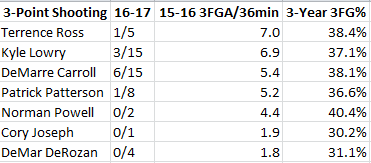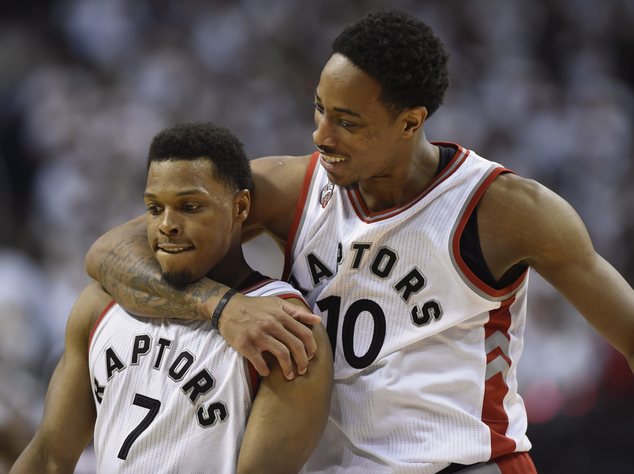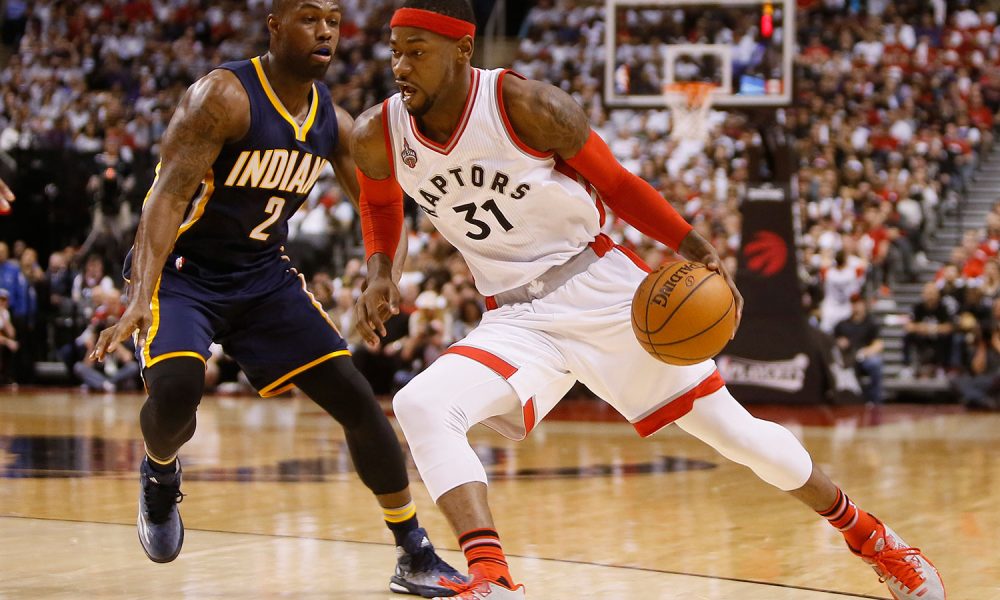As Pascal Siakam and Kyle Lowry attempted to navigated a pick-and-roll together, a slight miscommunication created a clutter of bodies above the left wing. When Lowry attempted to pull up over the screen, the pair hadn’t created enough space, and Emmanuel Mudiay was able to get a hand on Lowry’s attempt. A few long strides later, Will Barton was at the free-throw line capping a 7-0 run for the Denver Nuggets to start the half.
That shot is one of 12 3-point attempts Lowry has missed through three games. It’s symptomatic of a team-wide cold streak from beyond the arc, one that at least made the team’s shooting prowess a topic of conversation after the Toronto Raptors held on for the win on Monday. Yes, three games into the season, with a ludicrously small sample size, there is some concern that the Raptors not just can’t, but aren’t shooting threes.
Were the concern purely descriptive, it’s certainly worth noting. Toronto is 11-of-50 on triples, a woeful 22 percent, and they rank dead-last in the NBA in the percentage of their field-goal attempts that have come from beyond the arc. That the Raptors are 2-1 with the 11th-best offensive efficiency so far is encouraging, because they’ve essentially turned back the clock and subsisted almost entirely on shots inside the arc and at the free-throw line.
“I think that’ll come,” head coach Dwane Casey said Monday. “I trust the 3-ball, I trust our offense. Usually, our defense is gonna be ahead. I thought our offense would be ahead of our defense, but our defense is a little bit ahead of our offense right now, and I trust that those shots will fall.”
Before diving deeper into the 3-point struggles, it’s instructive to look at how the Raptors have come about their offense so far: DeMar DeRozan. That’s the long and short of it, really. DeRozan is averaging 35 points, turning in masterful offensive performances in triplicate. His usage rate is at an astronomical 37.8 percent, and in this case, there’s been little argument to be made that he should rein it in, as he’s been unstoppable from everywhere on the floor…inside the arc. DeRozan, of course, is yet to hit a triple, going 0-for-4. That’s fine – DeRozan’s true-shooting percentage is nudging a robust 60 percent – but it’s difficult for a team to generate threes when nearly 40 percent of their possessions are being used by a player who doesn’t rely on them. (DeRozan’s assist rate is also less than half of what it’s been the last three years, and he’s been a little shot-happy, but assist rate this early is determined to at least some degree by fluctuations in teammate shooting – more on that shortly.)
“His game, man. That’s his game,” Lowry said. “People say he don’t shoot threes, it don’t matter. You average 30 points without threes, it’s pretty impressive no matter what.”
The Raptors have also finally answered the cries of fans and shifted more possessions to Jonas Valanciunas, who has promised me he’ll hit a three at some point this season but who hasn’t even considered attempting one yet. A 24.1-percent usage rate for a center scoring pretty effectively is more than fine, but together, the Raptors are distributing a boatload of possessions to a pair of players who don’t shoot many threes and who haven’t been passing the ball a great deal, at least so far.
Understanding those realities of the offense so far makes the volume somewhat less concerning. The Raptors aren’t built to bomb – they finished 19th in total 3-point attempts last year and 15th in the percentage of shots that came from long-range – by nature of personnel and a heavy reliance on drives to the rim, but they should be able to hit at a higher clip.
The 2014-15 Raptors ranked fifth in the NBA by hitting 37 percent on threes, and there’s little reason to think the Raptors, collectively, won’t shoot as well. Of their top-eight shooters by volume, only Luis Scola (65/161) is gone, an absence that should be accounted for by the presence of DeMarre Carroll, who ranked third on the team in threes attempted per-36 minutes but played just 26 games last year. Carroll’s proving that early on, leading the team with six threes and a 40-percent mark from outside.
The team’s other shooters – Lowry, Terrence Ross, and Patrick Patterson, in particular – just haven’t shot well. Lowry is 3-of-15, but he’s shot 37 percent since the start of the 2010-11 season. Patterson seems to draw fans nuts with his inconsistencies from outside, and he’s carried off a shaky postseason as a shooter into the regular season with a 1-of-8 mark. This happened last season, too, though, and once the sample was expanded, Patterson wound up exactly where he was expected to – at 36.2 percent, just shy of the 36.7-percent mark he’s posted since the beginning of 2012-13. Ross, meanwhile, has surprised by only taking five attempts and hitting just one. This, after averaging seven three hoists per-36 minutes last year. Suffice it to say, Ross is going to start gunning at some point.
To put that differently, if we assumed immediate regression to everyone’s career 3-point mark (unfair given how variable quality of looks can be, but bear with me for simplicity), the Raptors would be shooting 37 percent (18.5-of-50).
And really, that’s all that’s at the heart of the team’s lack of threes so far: Two non-shooters eating the bulk of the offensive touches, a few timely misses (hi, Patterson) that stand out in the collective memory, and some small-sample theatre. Keep in mind that individual player 3-point shooting doesn’t stabilize until 750 attempts. 750! It’s incredibly frustrating to see players miss what appear to be easy, open looks, but that’s the nature of a high-variance shot like a triple.
Are you really concerned that these kind of shooting drop-offs are going to persist?
The Raptors have some 3-point shooting talent. Lowry, Ross, Carroll, and Patterson all grade as above-average for their positions, Cory Joseph and Norman Powell can knock them down in small doses, and when Lowry gets going, DeRozan’s become at least passable canning the open looks that result. Casey’s offense is never going to value the three above attacking advantages one-on-0ne (the Raptors are dead-last in passes per-game right now, and third-last adjusting for pace), and the growth of Valanciunas could ground-bound the team’s shot mix even further. The team’s rookies are no threat from outside, and that’s going to hurt when Siakam’s on the floor, in particular. The reliance on those two and the stale ball movement that can result may serve to decrease the quantity and quality of looks.
“It’s always important. It’s something that you almost can’t force, you make and make and make, try to put them in position to make it,” Casey explained earlier in the week. “Shooters never forget how to shoot we just we have faith in them, have confidence in them that they’re going to continue to make those shots.”
They’re not going to be the league’s worst 3-point shooting team, not with four high-volume bombers established as above-average shooters on a high volume.





